NFTAMMs: A Royalty Solution
Delve into the evolving landscape of NFT royalties as you explore the challenges of traditional fee-based systems. Discover the uncertainties surrounding voluntary mechanisms and journey with us through the innovative concept of creator-owned liquidity via NFTAMMs, which promises consistent rewards and improved liquidity.

An inevitable race to zero, just another fee to be grinded down by the glory and benevolence of the invisible hand.
For many, this has been the reluctant perception of artist royalties in NFTs as of late. It's been a continued point of contention in web3, and unfortunately the above assessment isn’t an entirely unfair one. Fees of all sorts do generally trend toward zero, as users will gravitate toward the cheapest option.
It is easy to look at historical trends and see the pro-royalty argument as noble but futile. Despite years of promises to artists about what web3 could do for them in regards to monetization and sustainable income, the market has made clear that ‘royalties’ where they are enforced or provided for by a traditional fee structure are simply not sustainable.
Volume has continually shifted toward platforms with looser royalty enforcement, and while falling on one’s sword in the name of standing up for artists may be admirable, it is not good business. Pandora’s box has been opened on low/zero royalty NFT trading and there’s not much to be gained in trying to close it, but does that nullify the need for mechanisms by which creators can gain from the long term continued success of their creations? Scatter certainly doesn’t think so.
Why did the secondary sale % platform fee model fail?
Over the last three years we have seen many different marketplace platforms attempt variations of the same fee model. Broadly speaking, there is a sale % for the platform and a sale % for the artist included in the secondary sale cost of the NFT, with these fees generally being put on the secondary seller to be taken from the sale price.
Approaches have varied and different platforms have offered different degrees of flexibility and enforcement, but looking at the story of NFTs thus far in its totality the trend is clear. Where secondary sales are concerned, volume gravitates towards the platform with the lowest cost to transact, and at the end of the day even if a fee is called a ‘royalty' it increases the cost of the transaction.
It's nice to imagine that all the major secondary platforms could agree to enforce royalties and hold firm, but even that would only be a band-aid solution to the issue. It is simply too easy and too profitable to pivot and market oneself as the ‘low-fee’ platform.
In other words, all marketplaces are going to zero.
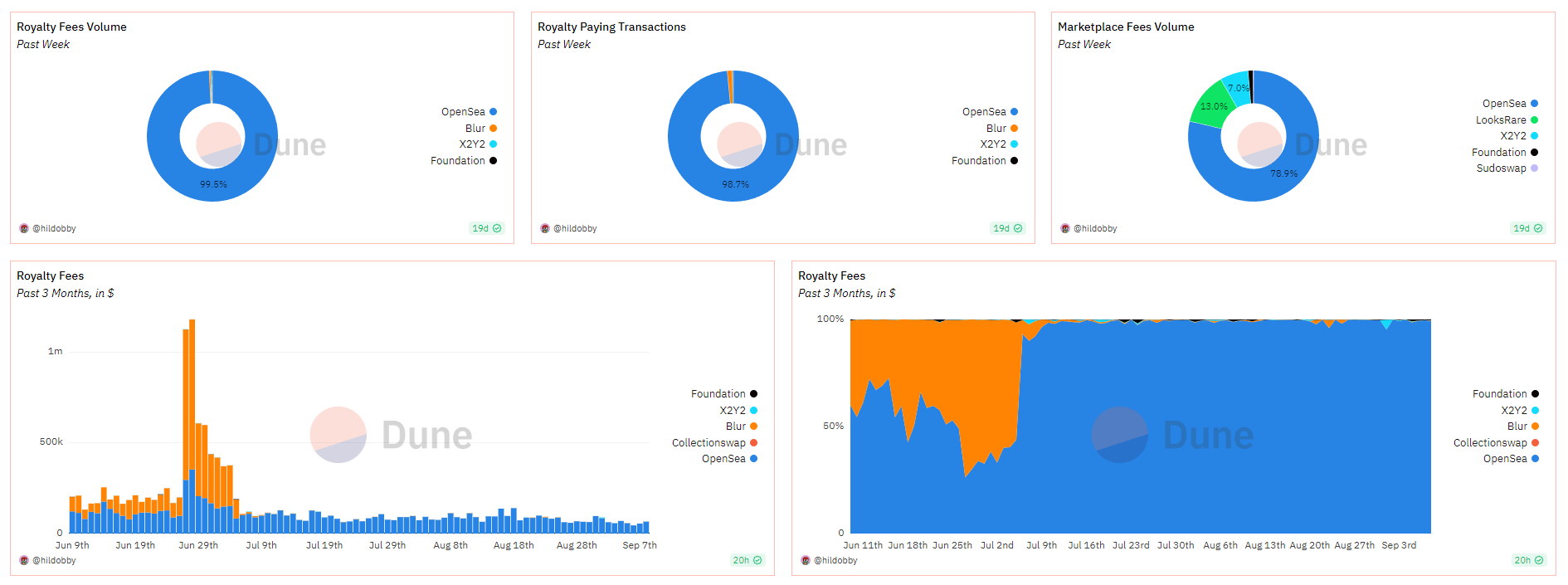
As a result of this “race to the bottom” as it is often called, the standard royalty mechanism has become an optional % which secondary sellers set themselves and opt in to. The voluntary royalty approach is well intentioned and admirable, but it's sustainability over the long term is questionable.
According to available data, the royalty situation is looking grim. We need to keep in mind however that we are deep in what many would call an NFT bear market, and royalties are currently a hot-button issue, with that in mind one might assume the current swell in voluntary royalties stems from an admirable ideological commitment from the communities still trading NFTs.
Will this scale when retail comes back however? When there are once again large funds speculating on NFTs, can we count on them to not cut costs by opting out of royalties? Moreover, why even call it a royalty if it's voluntary? Donations are fine, but let's call a spade a spade. So long as royalties are framed as a fee tacked on by the platform for the artist or a voluntary charitable gesture, there is no way to guarantee their sustainability over the long term.
Meanwhile platforms are still taking their cut even when the so-called "royalties" are considered optional.
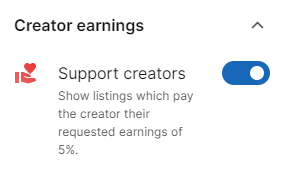
What’s the alternative?
Numerous ideas have been proposed as to what kind of mechanism may serve as a long term replacement for traditional royalty fees. RemiliaCo found Charlotte Fang once suggested an artist reserve, as an alternative to royalties. An artist reserve involves a collection’s team or creator holding back a number of NFTs from their collection for themselves, so that they can benefit from future price appreciation.
Artist reserves are a good start but somewhat limiting to the artist in terms of realizing the profits, as the reserve must be small enough so as to not dilute the community. Reserves also do not directly reward artists for sustained volume over time, yes high volume likely means an increase in price which mean an increase in the value of the artist’s reserve, but what if there was a way to ensure artists gain both from the price appreciation of their collection and the amount of continued on-chain activity/trading their collection seeing?
Enter NFTAMMs and creator owned liquidity.
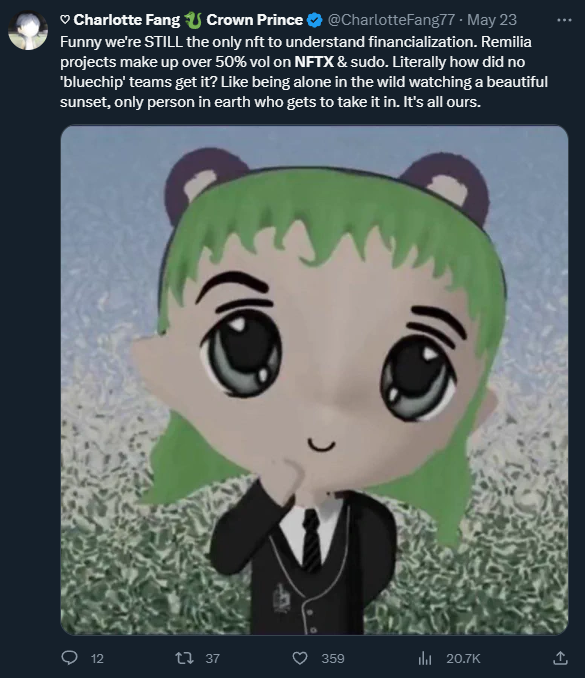
NFT automated market mechanisms (NFTAMMs) represent a decentralized trading platform variant, deploying algorithm-driven "digital brokers" to assist users in the seamless acquisition and liquidation of NFTs. Bypassing the conventional peer-to-peer trading seen in standard marketplaces, users engage directly with the NFTAMM interface to buy and sell.
NFTAMMs are nothing new. Simply put, they allow for the pairing of NFTs and ETH in liquidity pools so that NFT collections can be traded in and out of with ease. Similarly to ERC20 AMMs, the individuals providing two sided liquidity earn a portion of all transactions that occur in the pool.
Generally, these sorts of pools are established by teams or communities sometimes after a collection’s mint as a place for holders to swap NFTs within the collection for one another, and exit conveniently where necessary without needing to wait for floor sales or bids.
The pools also serve as an easy staking solution for the NFTs in question, with holders being able to stake their NFTs as either inventory (one sided) or liquidity (two sided) and earn a % of every trade that occurs within the pool. It seems plausible that these NFTAMM protocols could be utilized by creators as a replacement for royalty fees.
Imagine, a creator commits to a certain % of NFT supply and ETH proceeds from mint being plugged into two-sided liquidity, this could even be built in at the contract level so the relevant amount of eth is allocated on a per mint basis. Once this pool is established, there is immediate holder benefit as holders now have higher liquidity, allowing them to buy, sell, and swap with much less friction than on traditional NFT market places.
With the vault being seeded from mint proceeds, it should be the most liquid avenue for trading the collection. This ensures users seeking the best trade will opt for the pool over a regular marketplace.
With the collection trading a sizable portion of its volume through a pool to which the creator is providing LP, the creator should now, theoretically, receive rewards proportional to the ongoing volume activity being created by their collection, as was the intention of royalty fees to begin with.
Here we’ve created a scenario where holders are not being hit by an additional fee, the collection has increased liquidity, and the creator is guaranteed to earn directly in proportion to the collections success.
Many Scatter collections already have robust liquidity vaults across various protocols, and Scatter collections regularly dominated the top five trending section on NFTX (arguably the largest NFTAMM). Many of these vaults regularly pay between thirty and eighty percent annualized return, a very decent ongoing reward, especially if one assumes the value of the collection is going up.
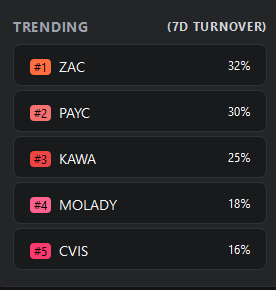
A creator owned liquidity scheme ties the creator’s success directly to the continued growth of the project. It would also provide uncertain potential minters assurance that there will be secondary liquidity available, which may make a mint much more enticing.
In this way, the creator owned liquidity and the fees earned by the team as a result, become a means of making the entire process from mint to mature secondary market smoother and more seamless, rather than a source of friction like traditional royalty fees.
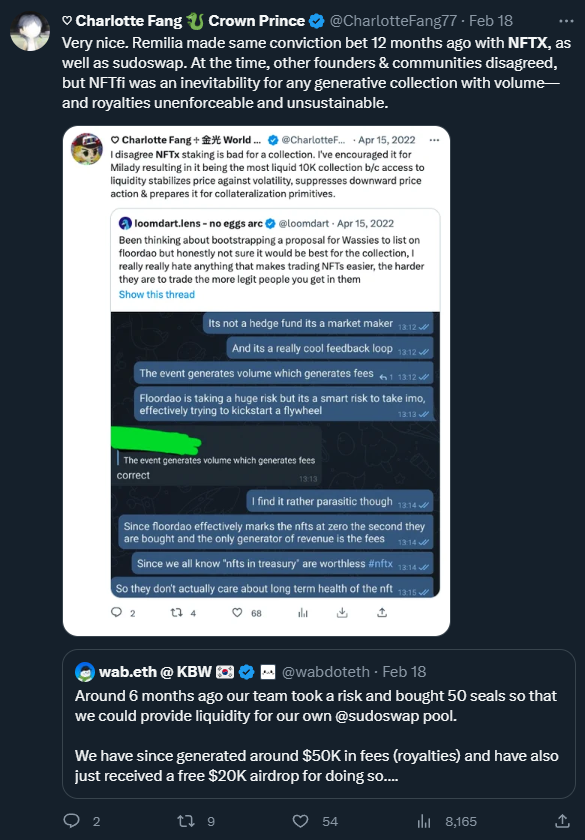
What could possibly go wrong?
Like any other potential royalty solution, creator owned liquidity has its shortfalls.
Some creators may not be willing to shoulder the capital commitment often required to launch a robust pool. This is understandable, however it comes down to a creator’s willingness to commit to the project.
The up-front burden on the creator could be eased by seeding the eth side of the pool with a portion of mint proceeds. It is also important to note, that due to how NFTAMMs currently work, rewards for staked LP are paid out in fractions of the collection’s NFTs (in erc20 form) rather than in ETH.
This means realizing these rewards will require the creator selling, either into the liquidity pool or on another secondary market. The optics of a creator selling can be concerning for some, however the same would be required in an artist reserve system.
Given liquidity providing would be open to anyone, as time goes on more holders can be expected to be adding to the vault's liquidity, thereby creating a greater cushion for any sell pressure created by the artist’s earnings. It is also true that NFTAMM vaults are not always appropriate for every collection. Collections with low supplies made up of 1/1 pieces for example are not befitting the fungible form NFTs take when in an AMM.
The Path Forward
In reality it is unlikely the NFT industry as a whole returns to a one size fits all approach a la royalty fees in 2021.
It is now clear that the space is trending toward segmentation and specialization.
There will be marketplaces that continue to enforce royalties, marketplaces that keep them optional, and marketplaces that avoid them so as to optimize for traders/speculators. Creator owned LP provides a consistent, platform neutral reward mechanism that also serves to bolster liquidity for the community.
This certainly makes it an attractive option to artists and teams, particularly during this time of conflict and uncertainty around royalty policy across various platforms. Moving forward Scatter aims to roll out features making things like the seeding of creator owned LP simpler, so that teams can be freer to forge their own destiny and have greater control over all aspects of their collection.
As for Scatter's long term view on the royalty question, when we launch our new marketplace, we will force a 5% creator fee without the ability to customize or opt out. 5% we feel is simple and fair. If you want to trade on Scatter, the artist is getting 5%. Until then, it's likely the best option for creators is to participate in the NFTAMMs of their collections.
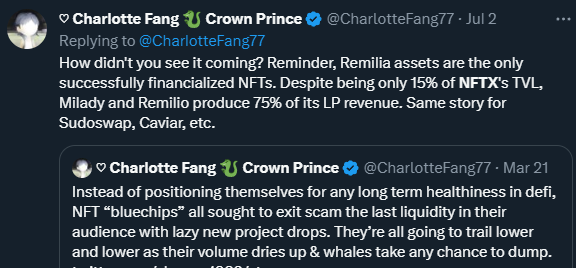
- Caviar - https://www.caviar.sh/
- NFTX - https://nftx.io/
- leNFT (New) - https://lenft.fi/
